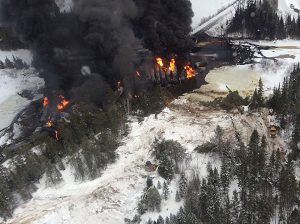Aug 3, 2017 @ 14:54
Today, the Transportation Safety Board of Canada (TSB) is recommending that Transport Canada (TC) incorporate predictive data on rail surface conditions to help better focus its targeted regulatory track inspections. The Board’s recommendation (R17-02) was issued as part of its investigation (R15H0021) into the March 2015 derailment and fire involving a Canadian National (CN) freight train near Gogama, Ontario.
On 7 March 2015, a CN unit train transporting 94 tank cars loaded with petroleum crude oil derailed on CN’s Ruel Subdivision near Gogama, Ontario. Although the train was travelling below the 50 mph speed limit, 39 tank cars derailed, spilling about 2.6 million litres of product, which ignited, caused explosions, and contaminated the nearby Makami River. A CN rail bridge was destroyed, along with about 1000 feet of track. There were no injuries.
“The investigation found that certain data on deteriorating rail surface conditions are not always considered by Transport Canada when it plans its inspections,” said Kathy Fox, Chair of the TSB. “By integrating data on these ‘leading indicators’—which could be predictive of future rail failures—the targeted inspections would be better focused.”
The investigation found that the derailment occurred after a recently repaired rail within a joint broke under the train. Three days prior to the accident, a track maintenance employee had repaired a broken rail by installing a plug rail. The employee had cut the defective rail out of the track, visually inspected the remaining exposed rail ends, and installed the plug rail. However, although required under CN standards, a dye penetrant test to find defects that are not always visible to the naked eye was not performed prior to the repair. As a result, a vertical split head, which is an internal defect, was not detected and remained in the south rail after the repair. Additionally, following the repair, the rail head ends within the joint were mismatched. To ease the transition between the rail heads, grinding on the plug rail head end was performed, but it was insufficient and a step between the two rail heads remained. Given the state of the repair, a mandatory “slow order,” which would have required trains to reduce speed at this location, should have been issued. This, however, was not done.
The TSB investigation showed that CN’s procedures for rail testing and installing a plug rail were located in multiple manuals, making them difficult to find. In addition, employees were not given checklists, which could have outlined the steps required to complete the work. The employee was aware of the dye penetrant test, but had not performed it or seen it done during the course of his duties. CN’s training did not highlight the importance of the test, nor did it provide opportunities for practical hands-on training.
With regard to improving future inspections, Chair Fox noted that Canadian railways regularly inspect their track networks for specified rail defects. “Railways gather information, including data on leading indicators, such as localized surface collapse, rail end batter, and crushed heads, and TC needs to acquire this information. Without it, the targeted TC track inspections simply won’t be as effective as they otherwise could be. This is the focus of the recommendation we issued today.”
See the investigation page for more information.
- Flash Freeze Warning - December 16, 2025
- Tuesday Morning News – December 16th - December 16, 2025
- Winter Road Conditions – Tuesday, December 16th - December 16, 2025
 Wawa-news.com You can't hear the 'big picture'!
Wawa-news.com You can't hear the 'big picture'!
